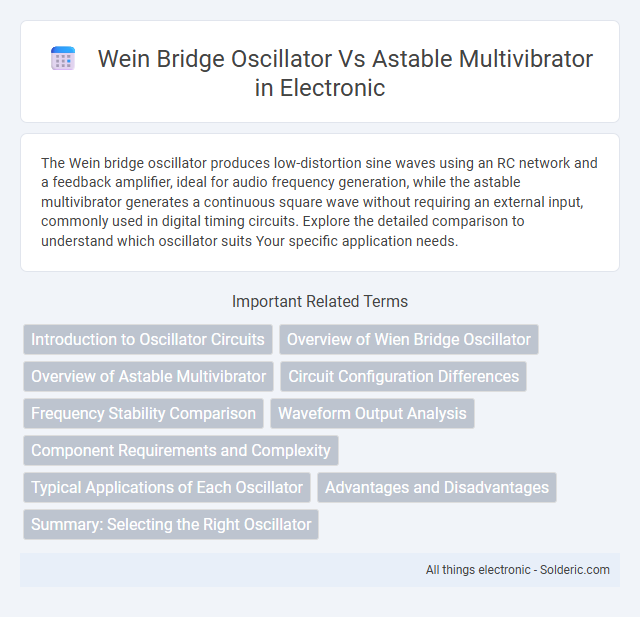The Wein bridge oscillator produces low-distortion sine waves using an RC network and a feedback amplifier, ideal for audio frequency generation, while the astable multivibrator generates a continuous square wave without requiring an external input, commonly used in digital timing circuits. Explore the detailed comparison to understand which oscillator suits Your specific application needs.
Comparison Table
| Feature | Wein Bridge Oscillator | Astable Multivibrator |
|---|---|---|
| Type | Sine Wave Oscillator | Square Wave Oscillator |
| Waveform Output | Sine | Square/Pulse |
| Frequency Stability | High Stability | Moderate Stability |
| Frequency Control | Resistor-Capacitor (RC) Network | Resistor-Capacitor (RC) Timing |
| Applications | Audio Signals, Signal Generators | Clocks, Timers, Pulse Generation |
| Complexity | More Complex Circuit | Simple Circuit |
| Output Amplitude | Stable Amplitude with Automatic Gain Control | Variable Amplitude, Typically Digital Levels |
| Power Consumption | Moderate | Low to Moderate |
Introduction to Oscillator Circuits
Oscillator circuits, such as the Wein bridge oscillator and the astable multivibrator, generate continuous waveforms essential for signal processing and timing applications. The Wein bridge oscillator produces low-distortion sinusoidal signals using a frequency-determining RC network and an amplifier with automatic gain control. Your choice depends on whether you need a stable sine wave, favoring the Wein bridge, or a square wave output, which an astable multivibrator readily provides through its transistor or IC-based switching action.
Overview of Wien Bridge Oscillator
The Wien Bridge Oscillator generates low-distortion sine waves using a combination of resistors and capacitors arranged in a bridge configuration, making it ideal for audio frequency applications and signal testing. Unlike an astable multivibrator, which produces square waves through transistor switching, the Wien Bridge oscillator provides stable, pure sine wave output with frequency determined by the RC network. Your choice of oscillator depends on whether a pristine sine wave or a square wave output suits your circuit requirements.
Overview of Astable Multivibrator
An astable multivibrator is an electronic oscillator circuit that continuously switches between its two unstable states, generating a square wave output without any external triggering. It finds widespread application in clock pulse generation, timing circuits, and LED flashing devices due to its simplicity and ability to produce a free-running waveform. Unlike the Wien bridge oscillator, which produces a sinusoidal output, the astable multivibrator is known for its robust digital signal generation in timing and switching applications.
Circuit Configuration Differences
The Wein bridge oscillator features a frequency-selective feedback network using resistors and capacitors configured in a bridge arrangement, ensuring stable and low-distortion sinusoidal output. In contrast, the astable multivibrator employs a pair of cross-coupled transistors or op-amps with timing components that generate continuous square wave oscillations without a stable state. Your choice between these circuits depends on the desired waveform type and application-specific frequency stability requirements.
Frequency Stability Comparison
The Wein bridge oscillator offers superior frequency stability due to its use of a frequency-selective feedback network and low distortion sine wave output, making it ideal for precision applications. In contrast, the astable multivibrator generates a square wave with frequency influenced by component tolerances and temperature variations, resulting in less consistent frequency performance. Your choice depends on whether you prioritize stable, low-distortion sinusoidal signals or simpler, less stable square wave generation.
Waveform Output Analysis
The Wein bridge oscillator produces a low-distortion sinusoidal waveform with a stable frequency determined by the RC network, making it ideal for audio and signal generation applications. In contrast, the astable multivibrator generates a square waveform with sharp transitions and a frequency set by the timing resistors and capacitors, commonly used in clock pulses and timing circuits. The sinusoidal output of the Wein bridge oscillator exhibits minimal harmonic content, whereas the astable multivibrator's square wave contains significant harmonic frequencies due to its abrupt edges.
Component Requirements and Complexity
The Wein bridge oscillator requires precision components such as resistors and capacitors with tightly controlled values to maintain frequency stability, along with an operational amplifier or transistor for amplification, making its circuit more complex. In contrast, the astable multivibrator typically uses fewer components, primarily transistors, resistors, and capacitors, arranged in a simpler feedback loop without the need for precision parts. This fundamental difference results in the Wein bridge oscillator being more suitable for sine wave generation with stable frequency, while the astable multivibrator excels in square wave generation with lower component complexity.
Typical Applications of Each Oscillator
Wein bridge oscillators are commonly used in audio signal generation, sine wave testing, and instrumentation due to their stable and low-distortion sine wave output. Astable multivibrators are ideal for clock pulse generation, timing circuits, and LED flashers, providing a continuous square wave output without requiring an external trigger. Your choice depends on whether a pure sine wave or a square wave output is essential for your electronic application.
Advantages and Disadvantages
The Wein bridge oscillator offers low distortion sinusoidal output and frequency stability, making it ideal for audio signal generation, but it requires precise component matching and has limited amplitude control. The astable multivibrator provides simple square wave generation with easy frequency adjustment and robust operation; however, it produces non-sinusoidal waveforms prone to harmonic distortion and less frequency stability. Selecting between these circuits depends on the need for waveform purity versus circuit simplicity and frequency tunability.
Summary: Selecting the Right Oscillator
Wein bridge oscillators provide low-distortion sine wave output suitable for audio and precise frequency applications, while astable multivibrators generate square waves ideal for digital clocking and timing circuits. Choosing between these oscillators depends on waveform purity, frequency stability, and application requirements. For audio signal generation, Wein bridge oscillators excel, whereas astable multivibrators excel in pulse generation and switching tasks.
wein bridge oscillator vs astable multivibrator Infographic

 solderic.com
solderic.com